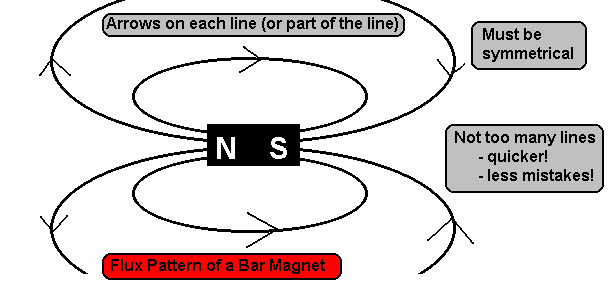Magnetism Click here to see the magnetism related topics split into keystages
(Also see Electromagnetism ) A magnet has two poles - the NORTH pole and the SOUTH pole. If freely suspended it will orientate itself so that the end called the North Pole points north. This is why it is called the North Pole - it seeks out the north. See the Earth's Magnetic field There are three magnetic elements: iron, nickel and cobalt. Only these and their alloys (mixtures of metals containing them) will be attracted to a magnet... all other metals will not. The Domain Theory tries to explain
why metals get magnetised. The magnetic elements have little molecular
magnets inside them. These are randomly orientated in an unmagnetized
piece of metal but point in a particular direction in a
magnetised piece.
Soft magnetic materials (e.g. iron) have domains that easily move into line when the metal is placed in a magnetic field but as soon as the field is removed the domains take on a random pattern again. It returns to being unmagnetized straight away. very little energy is required to magnetise a soft magnetic material Hard magnetic materials (e.g. steel) have domains that do not easily move into line when the metal is placed in a magnetic field, a strong field is needed for some time, but then, when the field is removed the domains retain the magnetic pattern. The metal stays magnetic for a long time. A lot of energy is required to magnetise a hard magnetic material. That energy is changed into heat within the material during the magnetism process. The Compass
If you put a magnet near a compass the arrow will point towards the magnet's South Pole. This is because:-
LIKE poles REPEL and OPPOSITE poles ATTRACT
You can use tiny compasses (plotting compasses) to plot out field lines of a magnet. The arrow of the little compasses are arranged tip to tail and the flux (or field) line direction is then given by the arrow head direction (North to South) Here is an interactive Java activity

The closer the lines are drawn to each other (the more densely packed the line pattern) the stronger the field. Always include an arrow on each line (N to S) or part of a line you draw. Field lines never cross (special
care is needed in diagrams!I). They start at a North pole and end on a
South pole or form a complete loop - they have no breaks or gaps
Click here for an interactive demonstration of iron filings around a magnet and here for the field lines when two or more magnets are used.
Making
magnets
Destroying magnets
Try the magnetism wordmaze: click here Magnetism and levitation - click here |
Follow me...
|








